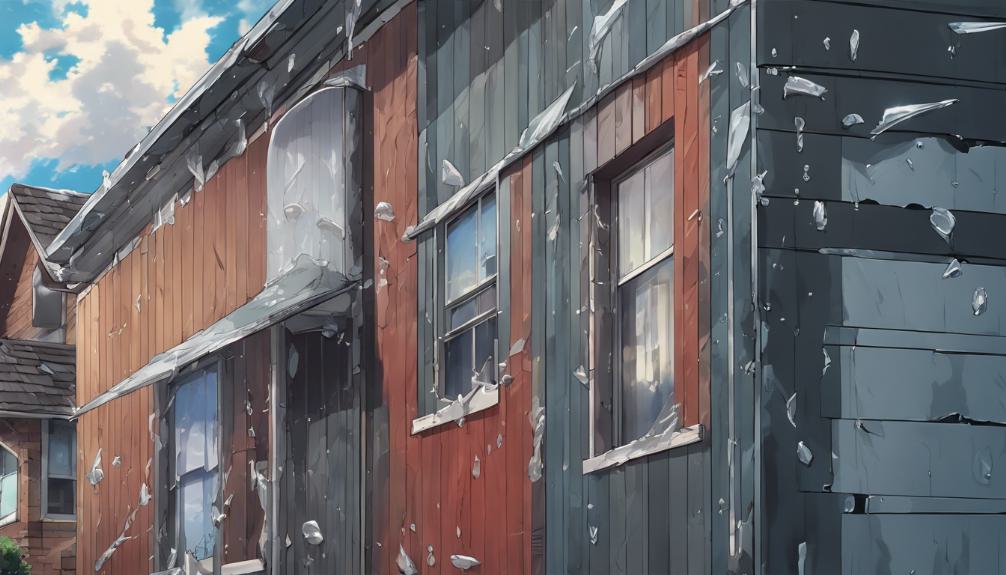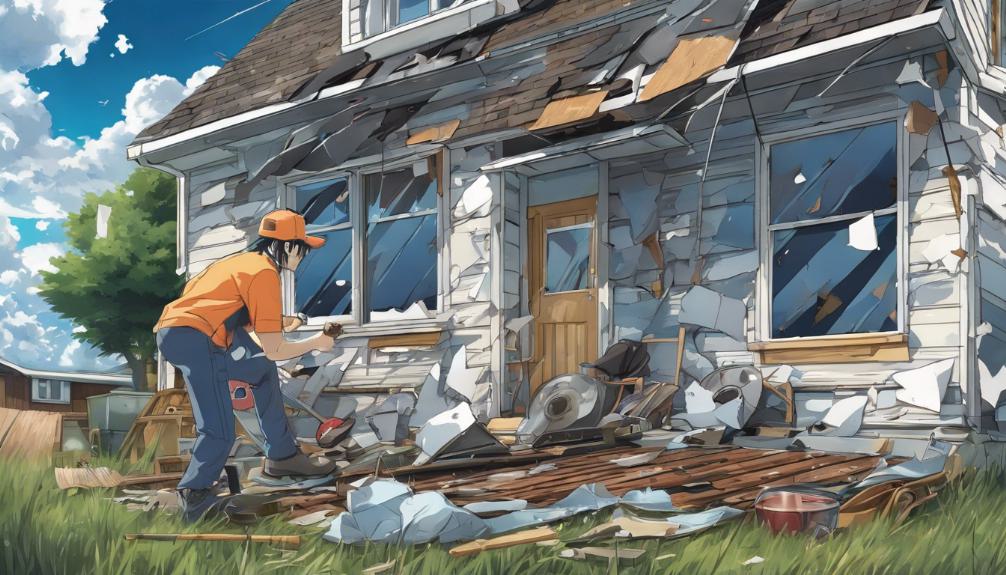Repairing vinyl siding damaged by hail involves specific steps to maintain your home’s appearance and value. Hailstorms can significantly damage your vinyl siding, but prompt and proper repair can restore it. Here’s how to fix hail-damaged vinyl siding effectively:
- Inspect the damage carefully.
- Clean the affected area.
- Measure and cut replacement siding.
- Remove damaged siding pieces.
- Install new siding securely.
By following these steps, you can ensure your home remains protected and visually appealing despite hail damage.
What Does Vinyl Siding Hail Damage Look Like?
Hail damage on vinyl siding appears as cracks, chips, and holes. After a hailstorm, inspect for dents, cracks, and holes to prevent further damage. Quick repairs ensure your home stays protected. Avoid delays in fixing these issues to maintain your siding’s integrity.
Factors That Influence Hail Damage
When considering factors that influence hail damage on vinyl siding, you should pay attention to the size and trajectory of the hailstones. Larger stones or those hitting at an angle can cause more severe damage. The age and condition of your vinyl siding also play a significant role. Older or brittle siding may be more prone to hail damage.
The quality of the siding material itself can determine how well it withstands hail impact. Investing in durable siding can help mitigate potential damage.
Size and Trajectory
The severity of hail damage on vinyl siding mainly depends on the hailstones’ size and how they hit the siding. Large hailstones can cause more damage, like dents, cracks, or holes.
The damage’s extent also depends on the hail’s speed and the angle of impact. Different siding materials may have varied levels of resistance to hail.
When fixing hail damage, it’s important to assess the hailstones’ specific characteristics to choose the best repair method.
Vinyl Siding Age and Condition
The condition and age of vinyl siding play a crucial role in its vulnerability to hail damage. Thicker siding generally resists hail better. The type of siding, such as insulated versus traditional, affects its durability against hail.
Pre-existing damage makes siding more prone to additional harm. Siding in good condition is less likely to suffer from hail impacts. Knowing these factors helps in evaluating the potential for hail damage to vinyl siding.
Siding Quality
High-quality, thicker vinyl or impact-resistant siding withstands hail better.
It’s durable and easier to repair after hail damage.
Choose high-quality siding to protect your home and save on repairs.
Types of Hail Damage: Minor vs Minor
When assessing hail damage on vinyl siding, distinguishing between minor and major damage is crucial.
Minor damage may include:
- Silver discoloration
- Powdery residue
- Breaks
- Cracks that can be easily repaired
Understanding the types of damage will help you prioritize repairs and ensure the longevity of your siding.
Silver Discoloration
Silver discoloration on vinyl siding, often due to minor hail damage, can impact the siding’s appearance and signal deeper issues. Here’s what to know:
- Appearance: This discoloration makes siding look older or damaged.
- Underlying Issues: It might show more serious damage beneath, weakening the siding’s structure.
- Water Risk: Damage, even minor, can allow water into the walls, posing a risk of internal damage.
- Act Quickly: Fixing discoloration early can avoid worse damage and costly repairs later.
Powdery Residue
The powdery residue on vinyl siding after a hailstorm often indicates minor damage, but it’s important to check for any cracks or breaks which suggest major damage. Here’s a quick guide:
- Minor Hail Damage: Only powdery residue, no other damage.
- Major Hail Damage: Visible cracks or breaks.
Clean the powdery residue with simple methods if that’s the only issue. For cracks or breaks, seek professional repair to protect your home.
Breaks
To assess storm damage on your vinyl siding, check for both minor and major breaks. Minor damage includes small cracks that don’t compromise the siding’s structure.
Major damage involves large breaks that expose the underlying structure, indicating a need for more extensive repairs.
Contact your insurance company to report the damage and check if repairs are covered.
Document the damage with photos and notes to support your insurance claim and ensure proper repairs.
Cracks
Checking your vinyl siding for cracks after a hailstorm is essential. Hail can cause cracks, leading to water damage, insulation issues, and pests.
Document any cracks with photos for your insurance. Get professional help to fix these damages quickly.
This keeps your home safe and helps with insurance claims.
Other Area to Check After a Hail Storm

After a hail storm, it’s crucial to inspect your home for damage in several key areas beyond the vinyl siding. These include:
- Roof: Look for any missing shingles, dents, or cracks.
- Windows: Check for any cracks or broken glass.
- Gutters: Examine for dents or other damage.
- Outdoor HVAC Units: Check the air conditioning unit for mechanical damage.
This inspection helps identify any damage needing repair after the storm.
How to Repair Hail Damage on Vinyl Siding
To repair hail damage on vinyl siding, start by assessing the damage and cleaning the area. Use a hairdryer for minor dents to heat and push them back into place.
For larger cracks or holes, apply a vinyl siding repair kit according to the manufacturer’s instructions. Check the siding after repair to ensure all damage is fixed.
This maintains your home’s integrity and appearance.
Vinyl Siding Hail Damage Versus Mechanical Damage

Identifying hail damage on vinyl siding involves different steps than spotting mechanical damage. Here’s how to tell them apart:
- Appearance: Hail damage shows as dents or cracks. Mechanical damage looks like scrapes or bends.
- Cause: Weather causes hail damage. Physical contact or bad installation causes mechanical damage.
- Repair Process: Fixing hail damage might mean replacing sections. Mechanical damage could need bigger repairs.
- Insurance Coverage: Check your insurance for hail or mechanical damage rules.
